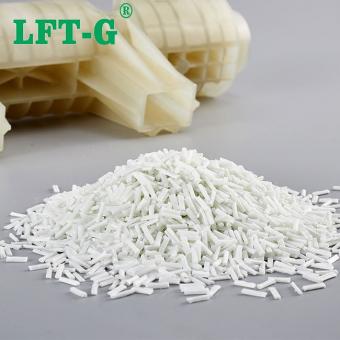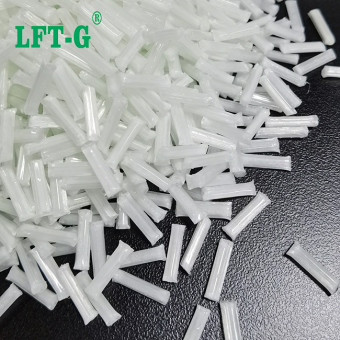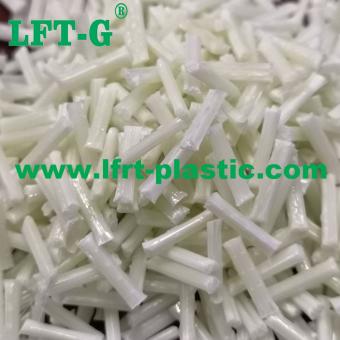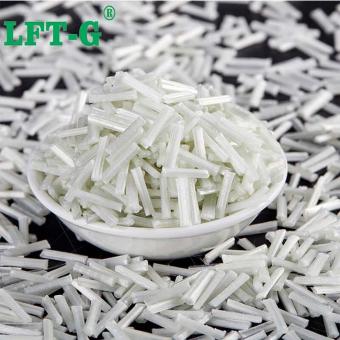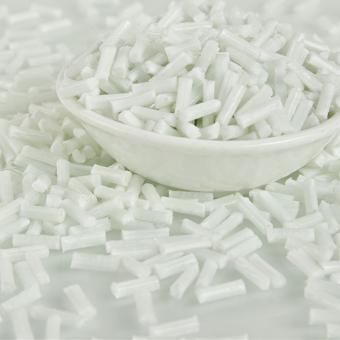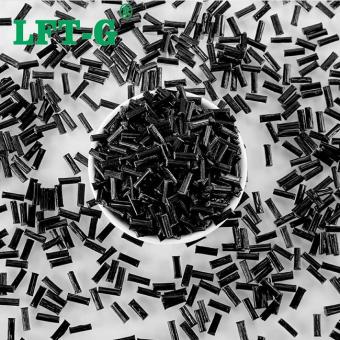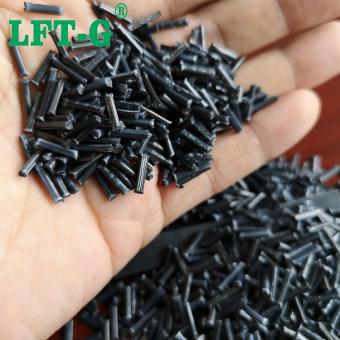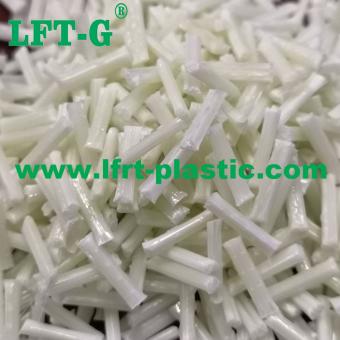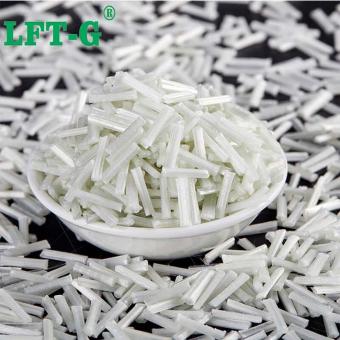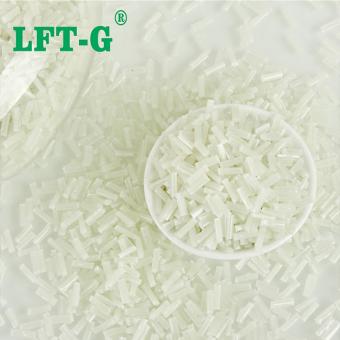-
LFT-G PLA Polylactic acid compounds long glass fiber thermoplastic resin original color recycled for engineeringPLA plastic PLA is a non-natural polyester, which is considered as one of the most promising "green plastics" because of its excellent properties such as biocompatibility, biodegradability and high mechanical strength. PLA has good degradability and can be completely degraded by microorganisms. Products made of PLA can be completely degraded to CO2 and water after use, and are non-toxic and non-irritating. PLA has similar mechanical properties to polypropylene, while its gloss, clarity and processability are similar to polystyrene, and its processing temperature is lower than that of polyolefin. PLA can be processed into various packaging materials, fibers and nonwovens through injection molding, extrusion, blistering, blow molding, spinning and other general plastic processing methods, and PLA has been widely used in disposable plastic products. In addition, PLA can also be widely used in chemical, medical, pharmaceutical and 3D printing industries. It is now increasingly recognized that PLA polyesters will play a key role in solving the plastic pollution problem. PLA reinoforced plastic Glass fiber (English name: glass fiber or fiberglass) is an inorganic non-metallic material with excellent performance, the advantages of good insulation, heat resistance, good corrosion resistance, and high mechanical strength. One of the main uses of glass fiber for the reinforcement of composite materials. Long glass fiber generally refers to the length of more than 10mm glass fiber. Long Glass Fiber Reinforced PLA plastic refers to modified PLA composites containing glass fiber lengths of 10 to 25 mm, which are formed into a three-dimensional structure with glass fiber lengths greater than 3.1 mm through injection molding and other processes, and is referred to as Long Glass Fiber PLA, abbreviated as LGFPLA. fiber reinforce thermoplastic). From the material definition, LGFPLA is a kind of LFT. Generally, they are columnar particles of 12mm or 25mm in length and about 3mm in diameter. The pellets of about 12mm length are mainly used for injection molding, while the pellets of about 25mm length are mainly used for compression molding. In these pellets, the glass fiber has the same length as the pellets, and the glass fiber content can vary from 20% to 60%, and the color of the pellets can be color-matched according to customer requirements. LGF & SGF LFT has the following advantages over short fiber reinforced thermoplastic composites: - Longer fiber length, which significantly improves the mechanical properties of the products. - High specific stiffness and specific strength, good impact resistance, especially suitable for automotive parts applications. - Improved creep resistance, good dimensional stability, and high precision of part molding. - Excellent fatigue resistance. - Better stability in high temperature and humid environment. - Fibers can move relatively in the molding mold during the molding process, with little fiber damage. Details Number Color Length Fiber specification Package Sample Port of loading Delivery time PLA-NA-LGF Natural color or as customized 6-25mm 20%-60% 25kg/bag Available Xiamen Port 7-15 days after shipment Lab & factory Xiamen LFT composite plastic Co., Ltd. The rapid development of technology has led to the emergence of LFT carbon fiber composites. Long Fiber (Xiamen) New Material Technology Co., Ltd, provides professional customization service for modified reinforced long carbon fiber composites. Ltd. was founded by a veteran of the thermoplastic reinforced composite industry, focusing on the development and production of (LFT-G.LFRT,LFT) long glass/carbon fiber reinforced thermoplastic engineering plastics. The company produces long carbon fiber composites with the advantages of light weight, high strength, high impact thermal resistance, design and recycleable, green and environmental protection. Compared with traditional materials, it requires lower cost, better corrosion and chemical resistance, and better molding and processing performance, making it the golden material of the 21st century. Long Fiber (Xiamen) New Material Technology Co: Xiamen LFT composite plastic Co., Ltd. is engaged in the development and production of LFRT series of long glass fiber (LGF) and long carbon fiber (LCF) PP, PA6, PA66, PPA, PA12, TPU, PBT, PLA, PET, PPS, PEEK and other engineering plastics. Series of products can be used in the manufacture of home appliances, aerospace, automotive, military, electrical and other parts, such as gears, rollers, pulleys, drums, pump impellers, fan blades, etc. They can also be used in the manufacture of medical equipment, sporting goods, daily necessities and other fields.
- PLA reinforced plastic lgf
- LFT-G PLA injection mold modified materials
- long glass fiber compounds pla resin basic
- PLA pellets of long fiber 30
- Self owing PLA polymers
- PLA pure pellets virgin grade lft
Tags :
-
lft-g PP polypropylene compounds long glass fiber high toughness lgf modified plastic can be recycled 5-24mmPP materials Product properties of long glass fiber reinforced PP. Higher impact toughness (even in low temperature environment), relatively high strength and hardness, safe impact effectiveness mode, better resistance to high temperature, good creep resistance and fatigue durability, relatively low wear characteristics, good dimensional stability, and excellent product appearance. When the content of glass fiber in long glass fiber reinforced PP is 40%, its tensile strength can reach 120MPa; when the content of glass fiber is 70%, its tensile strength is 30MPa, and its tensile strength is similar to that of pp raw materials without glass fiber reinforcement. Application Long glass fiber reinforced PP materials are widely used in automotive auto parts, including bumpers, instrument panels, rear door flaps, front-end components, seat support panels, noise partitions, battery brackets, etc., shifter bases, bottom guards, sunroof drains, etc. Long glass fiber reinforced PP can also be used in engineering and construction, aerospace industry. The high-temperature fatigue strength of long glass fiber reinforced pp at 120°C is twice that of ordinary glass fiber reinforced pp, and is even 10% higher than glass fiber reinforced nylon, which is known for its heat resistance, so this material has the durability and reliability required as a structural component. Long glass fiber reinforced pp has better warpage resistance than short glass fiber reinforced pp. Datasheet for reference LGF & SGF Details Number Color Length Fiber specification MOQ Sample Package Port of Loading PP-NA-LGF Natural or customized 5-25mm 20%-60% 25kg Available 25kg/bag Xiamen port Main products
- Long glass fiber Reinforced Polypropylene for electrial accessories
- PolyacticDegradable material
- pp lgf30 plastics resin price
- LFT-G pp raw materials filled lgf
- injection mold pp-lgf compounds
- home appliance parts plastic PP lgf
Tags :
-
LFT-G MXD6 compounds with long glass fiber filler high performance reinforced plastic customized virgin gradeMXD6 materials MXD6 is a crystalline polyamide resin, which is synthesized by condensation of m-phenylenedimethylamine and adipic acid. 1、Maintain high strength and rigidity in a wide temperature range 2、High heat deflection temperature, small coefficient of thermal expansion 3、Low water absorption, small size change after water absorption, less mechanical strength reduction 4、Small shrinkage rate of molding, suitable for precision molding process 5、Excellent paintability, especially suitable for surface painting under high temperature 6、Excellent barrier to oxygen, carbon dioxide and other gases MXD6-LGF materials MXD6 can be laminated with glass and carbon fibers for materials containing 20-60% glass fiber reinforcement with exceptional strength and stiffness. Even when filled with high levels of glass fiber, its smooth, resin-rich surface creates a high gloss surface as without glass fiber, making it extremely suitable for painting, metal coating or generating naturally reflective shells. 1. High fluidity for thin wall It is a very high flowing resin that can easily fill thin walls as thin as 0.5 mm thick even with glass fiber content as high as 60%. 2. Excellent surface finish The resin-rich perfect surface has a highly polished appearance, even with a high glass fiber content. 3. Very high strength and stiffness With 50-60% glass fiber reinforcement, MXD6 has a tensile and flexural strength similar to many cast metals and alloys. 4. Good dimensional stability At ambient temperature, the coefficient of linear expansion (CLTE) of MXD6 glass fiber composites is similar to that of many cast metals and alloys. It is highly reproducible due to low shrinkage and the ability to maintain tight tolerances (length tolerances can be as low as ± 0.05% if properly formed). Datasheet for reference produce processing Extrusion mold Injection mold Frequently asked questions Q. Does long glass fiber and long carbon fiber injection have special requirements for injection molding machines and molds? A. There are certainly requirements. Especially from the product design structure, as well as the injection molding machine screw nozzle and mold structure injection molding process must consider the requirements of long fiber. Q. How to choose the requirement method and length of the material when using long fiber reinforced thermoplastic material? A. The selection of materials depend on the requirements of the products. It is necessary to assess how much the content is enhanced and how much length is more appropriate, which are depending on the performance of the products. Q. Under what circumstances can long fiber replace short fiber? What are the common alternative materials? A. Traditional staple fiber materials can be replaced with long glass fiber and long carbon fiber LFT materials in the case of customers whose mechanical properties cannot be met or where higher metal substitutes are desired. For example, PP long glass fiber is often replacing nylon reinforced glass fiber, and nylon long glass fiber is replacing PPS series. We will offer you 1. LFT & LFRT material technical parameters and leading edge design 2. Mold front design and recommendations 3. Provide technical support such as inejction molding and extrusion molding Main products
- mxd6 granules lgf30
- lft-g mxd6 conposite plastic glass fiber
- injection mxd6 best price compounds
- thermoplastic resin pa12 with fiber
- low warpage electronic appliance
- mxd6 for engineering plastic long fiber
Tags :
-
LFT-G Polyamide 6 nylon materials filling glass fiber 20%-60% high mechanical properties sample availablePolyamide 66 filling long glass fiber PA66 is one of the most produced and widely used polyester series products. It has high grain size, excellent tensile properties, bending properties, tensile strength and other material mechanical properties, and its excellent ultra-low temperature characteristics and organic chemical properties. It is a class of rubber products with wide range of application, stable characteristics, good mechanical properties, high quality insulation, low density, easy processing and molding, self-extinguishing, and good wear resistance. Therefore, it is widely used in vehicles, electronic and electrical, chemical materials, industrial equipment, instrument panels, construction projects and other industries. However, it has high water absorption, poor alkali resistance, dry ultra-low temperature impact, low compressive strength and easy to deform after absorbing moisture, which affects the reliability of goods specifications. People have improved PA66 in a variety of ways, adding PA66 chemical fiber is one of them. After adding glass fiber, its impact force, heat deformation, material mechanical properties, molding processability and acid resistance are significantly improved. Glass fiber is a class of functional raw materials with high quality characteristics. This utility model has the advantages of low cost, non-combustibility, high temperature resistance, acid resistance, high tensile strength, high impact compressive strength, low tensile strength, high quality insulation properties, high quality insulation properties, etc. It is usually used as a raw material to improve organic chemical polymers or functional materials and composites. The most important hazard of proportional limits to raw materials is mechanical properties. The material mechanical properties of modified PA66 are also related to the composition of glass fibers. The tensile strength, bending strength and impact compression strength of PA66 increase with the glass fiber composition after the addition of PA66 chemical fibers. The tensile and flexural strengths of the managed system increased linearly, but the glass fiber composition was 30%. The trend of increasing tensile and flexural strengths showed some improvement. The results show that PA66 can produce a reasonable page layer, which can reasonably transfer the ground stress between the matrix and page, and thus improve the compressive strength of the matrix. Datasheet for reference Test Certifications Factory Xiamen LFT composite plastic Co., Ltd Xiamen LFT composite plastic Co., Ltd. is a brand-name company that focuses on LFT&LFRT. Long Glass Fiber Series (LGF) & Long Carbon Fiber Series (LCF). The company's thermoplastic LFT can be used for LFT-G injection molding and extrusion, and can also be used for LFT-D molding. It can be produced according to customer requirements: 5~25mm length. The company's long-fiber continuous infiltration reinforced thermoplastics have passed ISO9001&16949 system certification, and the products have obtained lots of national trademarks and patents. Main products
- pa66 nylon fill lgf home appliance parts
- pa66 compounds for electronic parts
- low warpage PA66 composite glass fiber
- thermoplastic resin pa66 with fiber
- electronic appliance part materials pa66 long fiber
- pa66 nylon filling long fiber white
Tags :
-
LFT-G HDPE raw materials filling LGF 30%-60% high toughness compunds pellets 12mm length sample freeHDPE High density polyethylene (HDPE), a granular product. Non-toxic, odorless, crystallinity of 80% ~ 90%, softening point of 125 ~ 135 ℃, the use of temperature up to 100 ℃; hardness, tensile strength and creep is better than low-density polyethylene; wear resistance, electrical insulation, toughness and cold resistance is better; good chemical stability, at room temperature, insoluble in any organic solvents, resistant to corrosion of acids, alkalis and various salts. Long glass fiber Glass fiber reinforced plastic is based on the original pure plastic, adding glass fibers and other additives, so as to improve the scope of use of the material. Generally speaking, most of the glass fiber reinforced materials are used in the structural parts of the products, which is a kind of structural engineering materials, such as: PP, ABS, PA66, PA6, HDPE, PPA, TPU, PEEK, PBT, PPS and so on. Advantages After glass fiber reinforcement, glass fiber is a high temperature resistant material, therefore, the heat-resistant temperature of reinforced plastics is much higher than before without glass fiber, especially nylon plastics. After the glass fiber reinforcement, due to the addition of glass fiber, the plastic polymer chain is restricted to move with each other, therefore, the shrinkage of reinforced plastics decreases a lot, and the rigidity is greatly improved. After glass fiber reinforced, the reinforced plastic will not stress cracking, at the same time, the impact resistance of the plastic improves a lot. After the glass fiber reinforcement, the glass fiber is a high strength material, which also greatly improves the strength of the plastic, such as: tensile strength, compression strength, bending strength, improve a lot. After glass fiber reinforcement, due to the addition of glass fiber and other additives, the combustion performance of the reinforced plastics decreases a lot, most of the materials can not be ignited, it is a kind of flame-retardant material. Datasheet Contact us
- HDPE filling long glass fiber white color
- high performance hdpe with lgf
- injection molded plastic hdpe virgin
- Original color 10-12mm hdpe pellets polymer resin
- engineering plastic can be recycled hdpe
- thermoplastic compounds hdpe high rigidity
Tags :
-
LFT-G Homo Polypropylene PP filling Long carbon fiber injection molding high toughness and strength compositesPP-LCF composites Polypropylene is a low-cost, excellent performance, widely used polymer materials, through the carbon fiber reinforced, can improve the strength, heat distortion temperature and dimensional stability of polypropylene materials, expanding the application of polypropylene materials, widely used in electronic and electrical appliances, automotive, construction and other fields. Especially in the automotive field, with the development of new energy vehicles and in the trend of automotive lightweight, carbon fiber reinforced materials in the automotive field is more and more widely used. Characteristics of long carbon fiber reinforced polypropylene materials Higher mechanical properties Simple production, easy molding, low warpage Lower density, lightweight, can replace steel with plastic Application The modified polypropylene material reinforced by carbon fiber has a series of advantages such as light weight, high modulus, high specific strength, low coefficient of thermal expansion, high temperature resistance, thermal shock resistance, corrosion resistance, good vibration absorption and so on, and it can be applied to automobile sub-instrument assembly and other automobile parts. Car Tool Kit Automotive front-end components More application fields, please contact us for more technical advice. Frequently asked questions 1. What are the types of thermoplastic carbon fiber composites? Carbon fiber thermoplastic composites are composites with carbon fiber as reinforcing material and thermoplastic resin as matrix. From the reinforcement of carbon fiber, it can be divided into long-cut carbon fiber (LCF)-reinforced thermoplastic composites, short-cut carbon fiber (SCF)-reinforced thermoplastic composites and continuous carbon fiber (CCF)-reinforced thermoplastic composites. Long-cut carbon fiber and short-cut carbon fiber mainly refers to the application length of carbon fiber materials, there is no strict fixed distinction between the two, generally between a few millimeters to a few centimeters, the more common specifications are 6mm, 12mm, 20mm, 30mm, 50mm. Carbon fiber thermoplastic composites can also be classified according to the thermoplastic resin, there are many common thermoplastic resins, such as PE, PP, PVC, etc., but the thermoplastic resin composites reinforced with carbon fibers are mostly used in aerospace, precision equipment, and other demanding working environments, so the carbon fiber thermoplastic composites are more commonly used in the form of polyetheretherketone (PEEK), PPS, polyimide ( Therefore, carbon fiber thermoplastic composites more often use polyether ether ketone (PEEK), PPS, polyimide (PI), polyetherimide (PAI) and other high-end thermoplastic resins as the matrix, to achieve the optimization of the material performance through the way of "strong alliance". 2. How do thermoplastic carbon fiber composites achieve low cost and environmental protection? Thermoplastic carbon fiber composites are used to make parts for high-end machinery, and they have excellent machinability, vacuum forming, stamping mold plasticity and bending processability, etc. Moreover, as long as the material reaches a certain temperature again, it can be remolded, which is recyclable and environmentally friendly in terms of the characteristics of the material itself. For example, Teijin Japan has been able to design a recycling process in the process according to the special needs, and the punched thermoplastic carbon fiber composite material trimmings are shredded, injection molded, and made into recycled materials, which can be used to make small products or injection molded nuts and studs on the carbon fiber prototype parts. This method can reduce the loss of raw materials to a greater extent, improve the use of thermoplastic carbon fiber composite materials, reduce the overall cost, so as to achieve the purpose of environmental protection. Production process of thermoplastic carbon fiber products In addition, thermoplastic carbon fiber composites, compared with thermoset carbon fiber composites, can shorten the molding cycle time due to its special process characteristics, which can further cut down the production cost in terms of production efficiency. 3. Are thermoplastic carbon fiber composites only suitable for injection molding? From the process point of view, injection molding and compression molding compared to a higher degree of automation, the raw material does not contact with the outside world, so the product appearance quality is guaranteed, there will be no black spots, impurities, uneven color and other issues, the mechanical properties of the product, dimensional stability and precision is relatively higher. At present, Toray, Japan, these carbon fiber giants in the application of carbon fiber reinforced thermoplastic composite materials, the main use of injection molding method, and this method is suitable for the production of complex shaped parts and mass production. Com...
- PP pellets lcf 30 polymer
- PP recycled for car parts electric parts
- Long carbon fiber Reinforced Polypropylene for electrial accessories
- LFT-G xiamen compounds pp plastic resin
- PP green materials instead metal
- Polypropylene filled lcf 30 40 50
Tags :
-
lft-g PA66 filled long carbon fiber 20%-60% nylon 66 modified plastic instead metal lightweight smaple availableWhat is the Polyamide 6 material Polyamide resin, the English name for polyamide, referred to as PA. commonly known as nylon (Nylon), it is a macromolecule repeating units in the main chain containing amide groups in the polymer of the general term. For the five engineering plastics in the production of the largest, most varieties, the most widely used varieties. PA66 (polyamide 66 or nylon 66), compared to PA6, is more widely used in the automotive industry, instrument housings and other products that require impact resistance and high strength. What is the Long carbon fiber (LCF) In the modified engineering plastics industry, long fiber reinforced composites are composites produced by a series of special modification methods using long carbon fibers, long glass fibers, aramid fibers, or basalt fibers and a polymer matrix. The biggest feature of long fiber composites is that they have superior performance that the original material does not have, if classified according to the length of the reinforcing material added, they can be divided into: long fiber, short fiber and continuous fiber composites. As mentioned at the beginning, long carbon fiber composites are one kind of long fiber reinforced composites, which is a new type of fiber material with high strength and high modulus fiber.LCF carbon fiber composites show high strength along the fiber axis direction, and have the characteristics of high strength, light weight, etc., and have a full range of mechanical properties such as density, specific strength, specific modulus and so on which are incomparable with other materials, which is a kind of new material with excellent mechanical properties and many special functions. It is a new material with excellent mechanical properties and many special functions. What are the advantages of PA66 filling LCF 1. Good mechanical strength 2. Excellent toughness 3. Excellent wear resistance and self-lubricating properties. 4. Good oil resistance 5. Excellent gas barrier 6. Excellent fluidity and moldability. 7. Excellent heat resistance Applications More application fields you can contact us for more technical advice. Exhibitions 2023 Certifications Quality Management System ISO9001/16949 Certification National Laboratory Accreditation Certificate Modified Plastics Innovation Enterprise Honorary Certificate Heavy metal REACH & ROHS testing Main materials
- pa66 nylon fill lcf home appliance parts
- nylon66 plastic resin modified carbon black
- virgin grade pa66 high performance own factory
- Xiamen LFT-G injection molding pa66
- pa66 composites compounds high quantities good price
- own factory made pa66 lcf pellets
Tags :
-
LFT-G MXD6 compounds with long glass fiber filler high performance reinforced plastic customized virgin gradeMXD6-LGF MXD6 can be laminated with glass fibers, filled with 30-60% long glass fibers, and has exceptional strength and stiffness. What sets this material apart is that even when filled with high levels of glass fiber, its smooth, resin-rich surface creates a high-gloss surface like that without the glass fiber, making it ideal for painting, metal coating, or generating naturally reflective housings. Advantages 1.High fluidity for thin walls MXD6 is a very high fluidity resin, even in the glass fiber content of up to 60%, it can still easily fill the thickness of only 0.5 mm thin wall. 2.Excellent surface finish The perfect surface of the resin-rich resin has a highly polished appearance, even with a high glass fiber content. 3.High strength and stiffness MXD6 add 30%-60% glass fiber reinforcement, its tensile and flexural strength is similar to many cast metals and alloys. 4.good dimensional stability At ambient temperature, the coefficient of linear expansion (CLTE) of MXD6 glass fiber composites is close to that of many cast metals and alloys. Reproducibility is excellent due to low shrinkage and the ability to maintain tight tolerances (if properly molded, length tolerances can be as low as ± 0.05%). Application Automotive Industry/Aerospace Aircraft/Construction Tools/Household Goods Other materials you may wonder PA6-LGF PA66-LGF PA12-LGF Certification Quality Management System ISO9001/16949 Certification National Laboratory Accreditaion Certificate Modified Plastics Innovation Enterprise Honorary Certificate Heavy metal REACH & ROHS testing Welcome to contact us
- Nylon MXD6 filling long glass fiber compounds
- engineering use plastic mxd6 reinforced
- car parts use modified plastic MXD6
- recycled plastic good price MXD6
- LFT-G xiamen compounds mxd6 plastic resin
Tags :
-
Xiamen LFT-G Polyamide 66 nylon materials reinforced plastic high mechanical properties customized color and lengthPolyamide 66 Nylon 66 (PA66) has excellent mechanical properties, processing performance and corrosion resistance, after flame retardant modification of PA66 can be widely used in automotive, electronics, machinery and other fields. With the wide application of nylon in different fields, the requirements for its performance have been taken to the next level. However, PA66 has high crystallinity and fast crystallization speed, and is prone to warpage defects during injection molding process. Especially for glass fiber reinforced nylon 66, due to the anisotropic arrangement of glass fibers inside the material, it is easy to cause different shrinkage rates in all directions, which further aggravates the warping deformation. Long glass fiber reinforced composites Glass fiber is an excellent performance of inorganic non-metallic materials, mostly used for reinforcing plastics. Mainly silica as raw material, add specific metal oxides mineral raw materials melted at high temperature, molten glass liquid flow through the leakage nozzle out of the role of high-speed pulling gravitational force is drawn and rapid cooling and curing into a very fine continuous fibers, the diameter of a few microns to more than twenty microns. Glass fiber is divided into short glass fiber, long glass fiber according to the shape. Short glass fiber: length less than 6mm, cross-section is round, in the material distribution disorder, anisotropy. Long glass fiber: length between 6-25mm, orderly distribution in the material, isotropic. Short Glass Fiber Nylon: Processability, rigidity and strength are improved, and floatation is less likely to occur during injection molding compared to long glass fiber nylon. Long glass fiber reinforced nylon: less anisotropic shrinkage compared to short glass fiber, reducing the effect of warpage. The rigidity, abrasion resistance, aging resistance, and heat resistance are stronger than those of short glass fiber reinforced nylon. Datasheet Application About us Xiamen LFT Composite Plastic Co.,LTD was established in 2009, is a brand-name global suppliers of long fiber reinforced thermoplastic materials integrating product research & development(R&D), production and sale marketing. Our LFT products have passed the ISO9001&16949 system certification and have obtained lots of national trademarks and patents, covering the fields of automotive, military parts and firearms, aerospace, new energy, medical equipment, power wind energy, sports equipment, etc.
- Polyamide 66 composite
- Polyamide 66 lgf filling lgf
- pa66 nylon plastic raw materials
- PA66 composite fiber car parts
- New high performance thermoplastic resin
- general grade pa66 compounds
Tags :
-
LFT-G TPU filled LGF 20%-60% lightweight for auto partsWhat is composites materials? ▶ Composite materials consist of two or more material components with different chemical and physical properties, combined in the designed form, proportion, and distribution, with obvious interfaces existing between the components; and ▶ Composite materials have structural designability, composite structure design can be carried out; not only to maintain the advantages of the performance of each component material, but also through the performance of each component complementary and related can be obtained by a single component material can not achieve the comprehensive performance. TPU composite materials have been widely used in various industries. LFT-G® TPU-NA-LGF It is a high-strength engineering composite material made of 80%-40% Baidu® high-performance polyurethane resins and 20%-60% glass fibers, produced by extrusion or injection molding process. Higher mechanical properties High glass fiber content leads to further improvement of the mechanical properties of the composites More uniform distribution of fibers in the composite material, more stable performance Injection molding process Datasheet we made for your reference More details please contacr us Application fields of TPU-NA-LGF Why choose Xiamen LFT-G? ▶Fast curing for improved productivity ▶Low viscosity, good fiberglass wettability ▶High stability, good product quality About Xiamen LFT composites plastic Co., Ltd. Xiamen LFT Composite Plastic Co.,LTD was established in 2009, is a brand-name global suppliers of long fiber reinforced thermoplastic materials integrating product research & development(R&D), production and sale marketing. Our LFT products have passed the ISO9001&16949 system certification and have obtained lots of national trademarks and patents, covering the fields of automotive, military parts and firearms, aerospace, new energy, medical equipment, power wind energy, sports equipment, etc.
- long fiber reinforced thermoplastics
- general grade TPU made by own factory
- green materials TPU raw materials
- long glass fiber compounds tpu modification
- TPU composite plastic
- anti-creep TPU plastic home appliance parts
Tags :
-
LFT-G industry use HDPE filling LGF 30%-60% high toughness pellets 12mm sample freeHDPE High density polyethylene (HDPE), a granular product. Non-toxic, odorless, crystallinity of 80% ~ 90%, softening point of 125 ~ 135 ℃, the use of temperature up to 100 ℃; hardness, tensile strength and creep is better than low-density polyethylene; wear resistance, electrical insulation, toughness and cold resistance is better; good chemical stability, at room temperature, insoluble in any organic solvents, resistant to corrosion of acids, alkalis and various salts. Long glass fiber Glass fiber reinforced plastic is based on the original pure plastic, adding glass fibers and other additives, so as to improve the scope of use of the material. Generally speaking, most of the glass fiber reinforced materials are used in the structural parts of the products, which is a kind of structural engineering materials, such as: PP, ABS, PA66, PA6, HDPE, PPA, TPU, PEEK, PBT, PPS and so on. Advantages After glass fiber reinforcement, glass fiber is a high temperature resistant material, therefore, the heat-resistant temperature of reinforced plastics is much higher than before without glass fiber, especially nylon plastics. After the glass fiber reinforcement, due to the addition of glass fiber, the plastic polymer chain is restricted to move with each other, therefore, the shrinkage of reinforced plastics decreases a lot, and the rigidity is greatly improved. After glass fiber reinforced, the reinforced plastic will not stress cracking, at the same time, the impact resistance of the plastic improves a lot. After the glass fiber reinforcement, the glass fiber is a high strength material, which also greatly improves the strength of the plastic, such as: tensile strength, compression strength, bending strength, improve a lot. After glass fiber reinforcement, due to the addition of glass fiber and other additives, the combustion performance of the reinforced plastics decreases a lot, most of the materials can not be ignited, it is a kind of flame-retardant material. Datasheet Contact usview more
-
LFT-G industry use HDPE filling LGF 30%-60% high toughness pellets 12mm sample freeHDPE High density polyethylene (HDPE), a granular product. Non-toxic, odorless, crystallinity of 80% ~ 90%, softening point of 125 ~ 135 ℃, the use of temperature up to 100 ℃; hardness, tensile strength and creep is better than low-density polyethylene; wear resistance, electrical insulation, toughness and cold resistance is better; good chemical stability, at room temperature, insoluble in any organic solvents, resistant to corrosion of acids, alkalis and various salts. Long glass fiber Glass fiber reinforced plastic is based on the original pure plastic, adding glass fibers and other additives, so as to improve the scope of use of the material. Generally speaking, most of the glass fiber reinforced materials are used in the structural parts of the products, which is a kind of structural engineering materials, such as: PP, ABS, PA66, PA6, HDPE, PPA, TPU, PEEK, PBT, PPS and so on. Advantages After glass fiber reinforcement, glass fiber is a high temperature resistant material, therefore, the heat-resistant temperature of reinforced plastics is much higher than before without glass fiber, especially nylon plastics. After the glass fiber reinforcement, due to the addition of glass fiber, the plastic polymer chain is restricted to move with each other, therefore, the shrinkage of reinforced plastics decreases a lot, and the rigidity is greatly improved. After glass fiber reinforced, the reinforced plastic will not stress cracking, at the same time, the impact resistance of the plastic improves a lot. After the glass fiber reinforcement, the glass fiber is a high strength material, which also greatly improves the strength of the plastic, such as: tensile strength, compression strength, bending strength, improve a lot. After glass fiber reinforcement, due to the addition of glass fiber and other additives, the combustion performance of the reinforced plastics decreases a lot, most of the materials can not be ignited, it is a kind of flame-retardant material. Datasheet Contact usview more

 e-mail
e-mail English
English français
français Deutsch
Deutsch русский
русский italiano
italiano español
español português
português العربية
العربية 日本語
日本語 한국의
한국의 中文
中文












